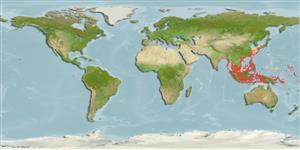Common names from other countries
Environment: milieu / climate zone / depth range / distribution range
Ecologia
marinhas associadas(os) a recifes; não migratória; intervalo de profundidade 15 - 80 m (Ref. 2295). Tropical; 35°N - 9°S
Indo-West Pacific: southern Japan to the Indo-Malaysian region, probably eastward to India. Has often been confused w/ the young of Gymnocranius grandoculis, hence its distributional limits are somewhat obscure. Records of Gymnocranius griseus from the Western Indian Ocean probably pertain to Gymnocranius grandoculis.
Tamanho / Peso / Idade
Maturity: Lm ? range ? - ? cm
Max length : 35.0 cm TL macho/indeterminado; (Ref. 2295); common length : 25.0 cm TL macho/indeterminado; (Ref. 2295)
Espinhos dorsais (total): 10; Raios dorsais moles (total): 9-10; Espinhos anais 3; Raios anais moles: 9 - 10.
In sheltered coastal bays and sand and mud slopes in depths over 20 m (Ref. 48635); also in coastal trawling grounds. Juveniles sometimes in shallow estuaries on algae reefs (Ref. 48635). Sometimes forms schools. Feeds on bottom-living invertebrates. Sexually mature upon reaching 15-17 cm SL. Sometimes caught with handlines and marketed dried (Ref. 9775) or fresh. In Hong Kong live fish markets (Ref. 27253).
Life cycle and mating behavior
Maturidade | Reprodução | Desova | Ovos | Fecundidade | Larvas
Carpenter, K.E. and G.R. Allen, 1989. FAO Species Catalogue. Vol. 9. Emperor fishes and large-eye breams of the world (family Lethrinidae). An annotated and illustrated catalogue of lethrinid species known to date. FAO Fish. Synop. 125(9):118 p. Rome: FAO. (Ref. 2295)
Categoria na Lista Vermelha da IUCN (Ref. 130435)
CITES (Ref. 128078)
Not Evaluated
Ameaça para o homem
Harmless
Utilização humana
Pescarias: espécies comerciais; peixe desportivo: sim
Mais informação
Nomes comunsSinónimosMetabolismoPredadoresEcotoxicologiaReproduçãoMaturidadeDesovaFecundidadeOvosDesenvolvimento dos ovos
Ferramentas
Relatórios especiais
Descarregue XML
Fontes da internet
Estimates based on models
Preferred temperature (Ref.
115969): 24.2 - 28.8, mean 28.1 (based on 445 cells).
Phylogenetic diversity index (Ref.
82804): PD
50 = 0.5010 [Uniqueness, from 0.5 = low to 2.0 = high].
Bayesian length-weight: a=0.01778 (0.00761 - 0.04154), b=2.97 (2.78 - 3.16), in cm Total Length, based on LWR estimates for this (Sub)family-body shape (Ref.
93245).
Nível Trófico (Ref.
69278): 3.2 ±0.44 se; based on food items.
Resiliência (Ref.
120179): Médio, tempo mínimo de duplicação da população 1,4 - 4,4 anos (K=0.22).
Fishing Vulnerability (Ref.
59153): Moderate vulnerability (38 of 100).
